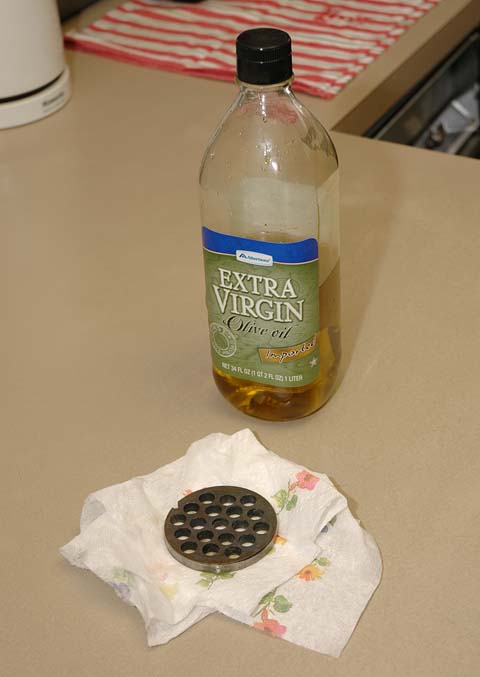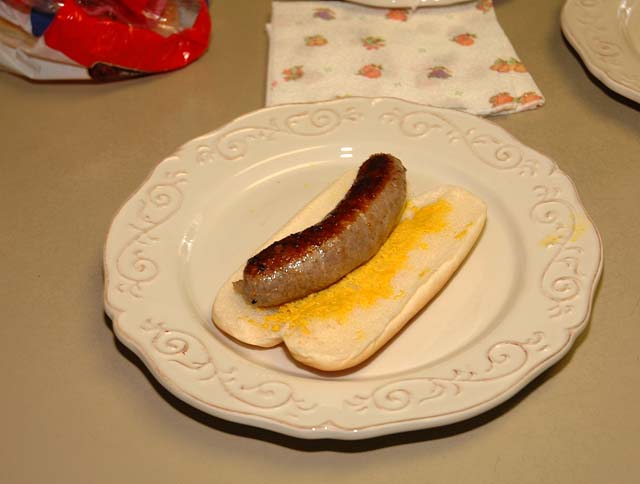Here's one final tip. Your grind plates will rust rapidly. Be sure to dry them completely. Store them in a zip lock plastic bag, with a light coating of olive oil or other cooking oil. Instead of using an oil, you could place some uncooked rice in the bag to absorb moisture. As you started, end by cleaning all of your tools.
Don't forget the Two "C"s.
Last but not least, and probably the most fun part of the whole process, is to reward yourself by cooking up a couple of links. Don’t forget that when you clean the meat grinder the fresh meats in the auger section will make a good reward taste too.
Enjoy!
Enjoy!
-=- Jerry -=-
(Click on Pictures for a full size view, use your browser's Back button to return)





11 comments:
Wow! Great information. You make it look so simple that I can't wait to try making some sausage.
Excellent info and wonderful pictures. Thanks for sharing.
Nate in NH
Jerry,
Okay, now that I read through the whole thing I see it's not identical to mine. But I do agree on the one-grind method.
The cutting and mixing with the spices before the grind is an eye-opener -- I always just put some of the meat, then some of the spices into the grinder. Brilliant! I totally agree that you don't want some spot in the middle of some sausage where there's a huge amount of garlic, or peppers or whatever.
Bruce Aidells etc. never mention this part -- thanks for the great tip.
Thank You All for your Very Nice Comments!
ChefNick, I only published one of your comments, but I did see the other. The work is of course my own, and it probably suffers somewhat from my Hand! LOL.
Anyway, I'm glad I have provided a few tips and Ideas for you all.
Best Regards!
This is a nicely done tutorial. I think you should probably mention that if you bought fresh meat and froze it and then thawed it and made sausage, you shouldn't freeze it again without first cooking the sausages. It's very dangerous to thaw raw meat then re-freeze it.
Hi, great tutorial! Only one thing though. You say to freeze the goods when you are finished if you have to, but if the meat comes frozen in the first place is it not dangerous to re-freeze or is that an old wives tale?
I would certainly never advocate anything that I thought would be dangerous to anyone's health. I have never had any trouble freezing the sausages I make out of meat that has been purchased frozen. But, if you have a concern, please follow your own conscience. I will look into this issue. Thank you for the comments.
Here is a link to the USDA that addresses re-freezing meats.
http://www.fsis.usda.gov/Fact_Sheets/keeping_food_Safe_during_an_emergency/index.asp
Basically it says to thaw in the referigerator, never let the meat get above 40 F. and it will be safe to re-freeze.
As I state in "Clean and Cold" keep the meats you are working on as cold as possible.
Please use your own judgment on this issue. The fact that I have not had a spoilage problem does not mean that you won't.
Stay safe and stay healthy.
The problem with refreezing meat is that the meat cells, when initially frozen, the liquid expands and turns to ice which breaks the cell wall. When you thaw it you get 'purge'; the juices run out of the meat. If thawed improperly (i.e. @ too warm a temp) this purge can grow bacteria rapidly. Then, you refreeze and the bacteria is added to your product. On the second thaw it continues to proliferate rapidly and can quickly spoil your product and send you to the E.R. The whole concept is to keep the temperature over 32 deg. but under 40 deg. where bacteria won't proliferate rapidly.
Initally freezing pork has a benefit.. Certified pork is pork that has been frozen at 30 deg below zero for 30 days or longer. This process kills trichinosis (which resides only in the fat, not the lean). Then it is unthawed in strictly controlled conditions and kept at 32 deg (called a 'hard chill') and sold from packer to processor. It can then be processed and repackaged and refrozen.
cool blog jerry. it really is that easy & a lot of fun too.
Wouldn't it be easier to wear rubber gloves than use the tongs for everything?
Post a Comment